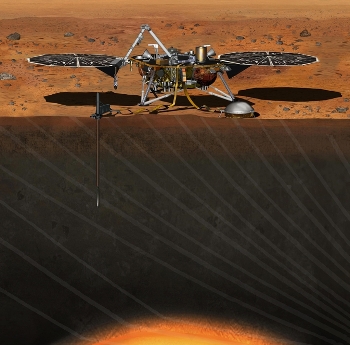May 20 2014
NASA and its international partners now have the go-ahead to begin construction on a new Mars lander after it completed a successful Mission Critical Design Review on Friday.
 NASA’s Interior Exploration Using Seismic Investigations, Geodesy and Heat Transport (InSight) mission will pierce beneath the Martian surface to study its interior. Launch is scheduled for March 2016. Image Credit: NASA
NASA’s Interior Exploration Using Seismic Investigations, Geodesy and Heat Transport (InSight) mission will pierce beneath the Martian surface to study its interior. Launch is scheduled for March 2016. Image Credit: NASA
NASA’s Interior Exploration Using Seismic Investigations, Geodesy and Heat Transport (InSight) mission will pierce beneath the Martian surface to study its interior. The mission will investigate how Earth-like planets formed and developed their layered inner structure of core, mantle and crust, and will collect information about those interior zones using instruments never before used on Mars.
InSight will launch from Vandenberg Air Force Base, on the central California coast near Lompoc, in March 2016. This will be the first interplanetary mission ever to launch from California. The mission will help inform the agency’s goal of sending a human mission to Mars in the 2030s.
InSight team leaders presented mission-design results last week to a NASA review board, which approved advancing to the next stage of preparation.
“Our partners across the globe have made significant progress in getting to this point and are fully prepared to deliver their hardware to system integration starting this November, which is the next major milestone for the project," said Tom Hoffman, InSight Project Manager of NASA's Jet Propulsion Laboratory (JPL), Pasadena, California. "We now move from doing the design and analysis to building and testing the hardware and software that will get us to Mars and collect the science that we need to achieve mission success."
To investigate the planet's interior, the stationary lander will carry a robotic arm that will deploy surface and burrowing instruments contributed by France and Germany. The national space agencies of France and Germany -- Centre National d’Etudes Spatiales (CNES) and Deutsches Zentrum für Luft- und Raumfahrt (DLR) -- are partnering with NASA by providing InSight's two main science instruments.
The Seismic Experiment for Interior Structure (SEIS) will be built by CNES in partnership with DLR and the space agencies of Switzerland and the United Kingdom. It will measure waves of ground motion carried through the interior of the planet, from "marsquakes" and meteor impacts. The Heat Flow and Physical Properties Package, from DLR, will measure heat coming toward the surface from the planet's interior.
"Mars actually offers an advantage over Earth itself for understanding how habitable planetary surfaces can form," said Bruce Banerdt, InSight Principal Investigator from JPL. "Both planets underwent the same early processes. But Mars, being smaller, cooled faster and became less active while Earth kept churning. So Mars better preserves the evidence about the early stages of rocky planets' development."
The three-legged lander will go to a site near the Martian equator and provide information for a planned mission length of 720 days -- about two years. InSight adapts a design from the successful NASA Phoenix Mars Lander, which examined ice and soil on far-northern Mars in 2008.
"We will incorporate many features from our Phoenix spacecraft into InSight, but the differences between the missions require some differences in the InSight spacecraft," said InSight Program Manager Stu Spath of Lockheed Martin Space Systems Company, Denver, Colorado. "For example, the InSight mission duration is 630 days longer than Phoenix, which means the lander will have to endure a wider range of environmental conditions on the surface."
Guided by images of the surroundings taken by the lander, InSight's robotic arm will place the seismometer on the surface and then place a protective covering over it to minimize effects of wind and temperature on the sensitive instrument. The arm will also put the heat-flow probe in position to hammer itself into the ground to a depth of 3 to 5 yards (2.7 to 4 1/2 meters).
Another experiment will use the radio link between InSight and NASA's Deep Space Network antennas on Earth to precisely measure a wobble in Mars' rotation that could reveal whether Mars has a molten or solid core. Wind and temperature sensors from Spain's Centro de Astrobiologia and a pressure sensor will monitor weather at the landing site, and a magnetometer will measure magnetic disturbances caused by the Martian ionosphere.
InSight's international science team is made up of researchers from Austria, Belgium, Canada, France, Germany, Japan, Poland, Spain, Switzerland, the United Kingdom and the United States. JPL manages InSight for NASA's Science Mission Directorate, Washington. InSight is part of NASA's Discovery Program of competitively selected missions. NASA's Marshall Space Flight Center in Huntsville, Alabama, manages the Discovery Program. Lockheed Martin will build the lander and other parts of the spacecraft at its Littleton, Colorado, facility near Denver.